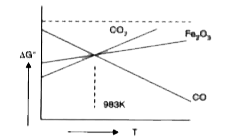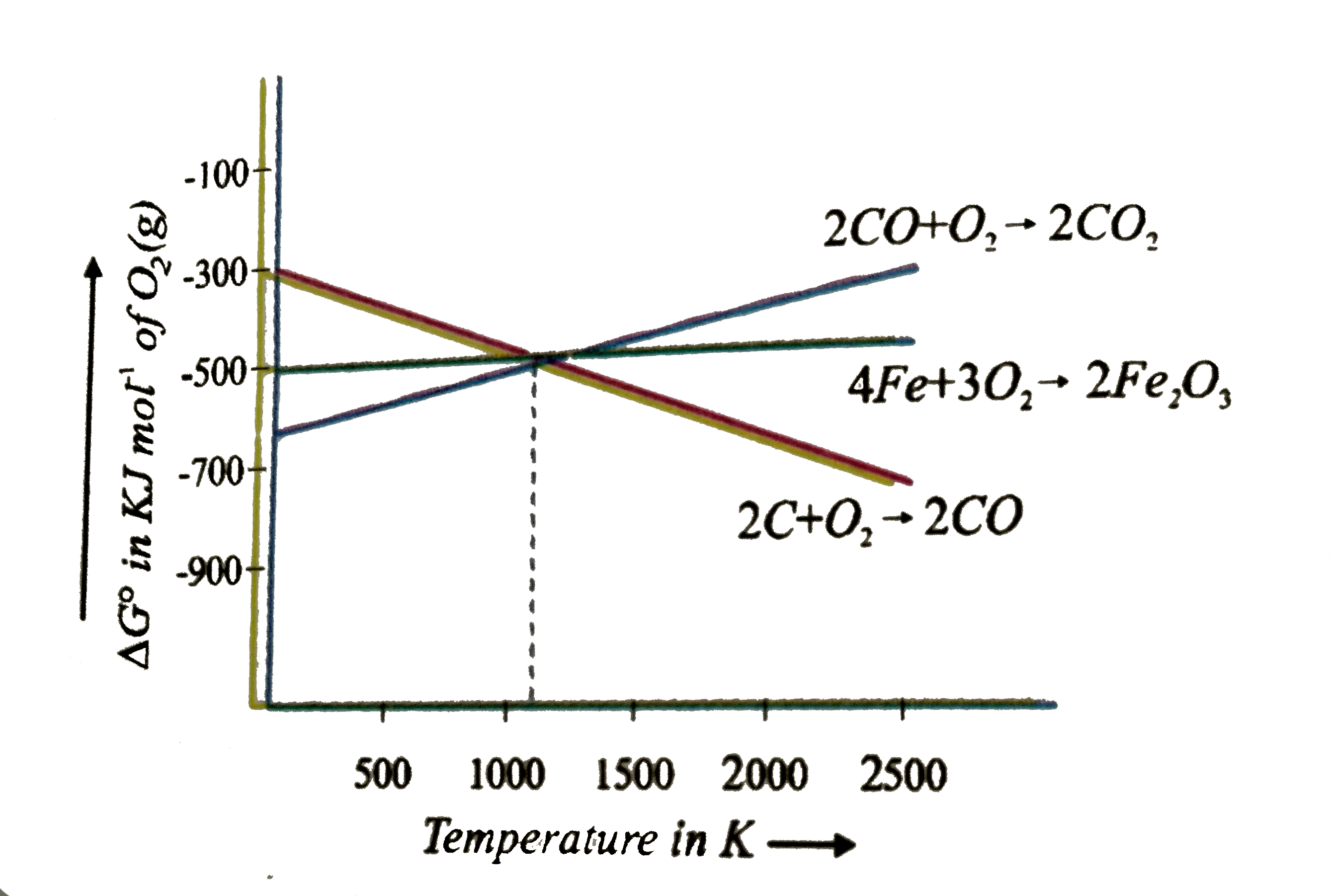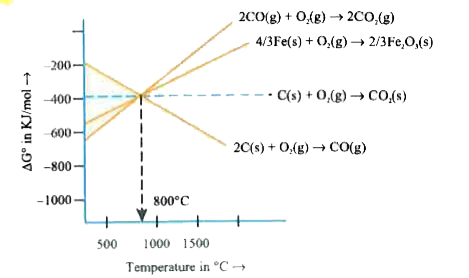Draw Ellingham diagram [ΔG∘VsT] for the oxidation of carbon monoxide and for the formation of Fe2O3 and CO. Suggest suitable reducing agents for the reduction of Fe2O3 at a temperature below 983 K (710∘C) and at a temperature above 983 K. Solution in Kannada
Ellingham diagram for CO
Ellingham diagram for CO2 and Fe2O3
Below 983K - CO
Above 983K - C

Topper's Solved these Questions
- BOOK - OSWAAL PUBLICATIONCHAPTER - GENERAL PRINCIPLES AND PROCESSES OF ISOLATION OF ELEMENTS EXERCISE - TOPIC 2 (LONG ANSWER TYPE QUESTIONS-II)2videos
GENERAL PRINCIPLES AND PROCESSES OF ISOLATION OF ELEMENTS
- BOOK - OSWAAL PUBLICATIONCHAPTER - GENERAL PRINCIPLES AND PROCESSES OF ISOLATION OF ELEMENTS EXERCISE - TOPIC 2 (SHORT ANSWER TYPE QUESTION-I)15videos
GENERAL PRINCIPLES AND PROCESSES OF ISOLATION OF ELEMENTS
- BOOK - OSWAAL PUBLICATIONCHAPTER - ELECTRO-CHEMISTRY EXERCISE - Topic - 3 ELECTROLYSIS , LAWS OF ELECTROLYSIS, BATTERIES, FUEL CELLS AND CORROSION (LONG ANSWER TYPE QUESTIONS)4videos
ELECTRO-CHEMISTRY
- BOOK - OSWAAL PUBLICATIONCHAPTER - HALOALKANES & HALOARENESEXERCISE - Topic 2 (Properties of Haloarenes and Haloalkanes) (Long Answer Type Questions - II)1videos
HALOALKANES & HALOARENES
Similar Questions
Predict conditions under which Al might be expected to reduce MgO.
02:34View SolutionSuggest any two methods to prevent corrosion of iron.
01:11View Solution(a) What type of a battery is the lead storage battery? Write the anode and the cathode reactions and the overall reaction occuring in a lead storage battery when current is drawn from it.
(b) In the button cell, widely used in watches, the following reactions takes place:
Zn(s)+Ag2O(s)+H2O(l)→Zn2+(aq)+2OH−(aq)
Determine E∘andΔG∘ for the reaction:01:11View SolutionDo the following conversions :
(i) Toluene to benzyl alcohol
(ii) Ethanol to but - 2 - yne
(iii) Ethanol to propane nitrile
(iv) Propane to propan-1-ol
(v) Ethyl chloride to propanoic acid.View SolutionCarbon monoxide is more effective reducing agent than carbon below 983K but above this temperature, the reverse is true. How would you explain this ?
View SolutionReduction of Fe_(2)O_(3) with CO is done below 710^@C . Delta_(f) G^(Ө) is negative at this temperature , this process is spontaneous.
View SolutionReduction of Fe2O3 with CO is done below 710∘C.
ΔfGӨ is negative at this temperature , this process is spontaneous.View SolutionCorrect statements from the graph

I) Above 1073 K,ΔG0 for the formation of F2O3 is less negative than ΔG0 for the formation of CO from carbon
II) Above 1073K, Carbon can reduce Fe2O3
III) Below 1073K, CO can reduce Fe2O3
IV) In blast furnance, reduction of Fe2CO3 occurs in different temperature ranges with below 1073K by CO (or) above 1073 K by carbonView SolutionDirect reduction of Fe_(2)O_(3) by Carbon is possible at temperature.
View SolutionUsing the Ellingham diagram given below.
Carbon monoxide is more effective reducing agent than carbon below 983 K but, above this temperature, the reverse is true - Explain.View SolutionUsing the Ellingham diagram given below.
It is possible to reduce Fe2O3 by coke at a at temperature around 1200 K.03:35View SolutionWhich one is good reducing agent (C or CO) for Fe_(2)O_(3) , below 1073 K ?
05:18View SolutionCorrect statements form the graph

I) Above 1073K, ΔG0 for the formation of Fe2O3 is less negative than ΔG0 for the formation of CO from carbon
II) Above 1073K, Carbon can reduce Fe2O3
III) Below 1073K, CO can reduce Fe2O3
IV) In blast furnace, reduction of Fe2O3 occurs in different temperature ranges with below 1073K by CO (or) above 1073K by carbon02:04View SolutionCarbon monoxide is more effective reducing agent than carbon below 983 k but, above this temperature, the revere is true -Explain.
03:58View SolutionCarbon can reduce ferric oxide to iron at a temperature above 983 K because
02:51View Solution

